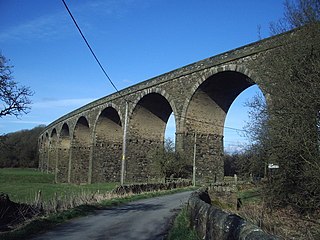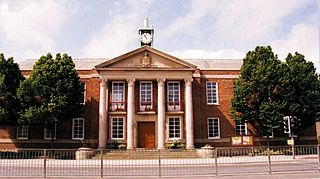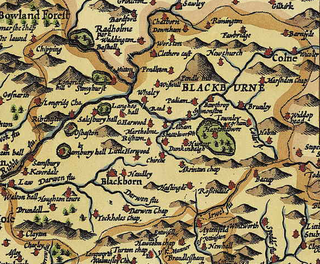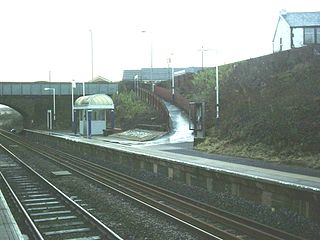
Read is a village in Lancashire 5 miles west northwest of Burnley and 2 miles east of Whalley. It is on the A671 which is the main road between Burnley and Clitheroe. The population of the civil parish as taken at the 2011 census was 1,419.

Burnley is a town and the administrative centre of the wider Borough of Burnley in Lancashire, England, with a 2001 population of 73,021. It is 21 miles (34 km) north of Manchester and 20 miles (32 km) east of Preston, at the confluence of the River Calder and River Brun.

Padiham is a town and civil parish on the River Calder, about three miles (5 km) west of Burnley, Lancashire, England. It forms part of the Borough of Burnley. Originally by the River Calder, it is edged by the foothills of Pendle Hill to the north-west and north-east. The United Kingdom Census 2011 gave a parish population of 10,098, estimated in 2019 at 10,138.

The Borough of Burnley is a local government district with the borough status in Lancashire, England. It has an area of 42.7 square miles (110.7 km2) and a population of 94,646 (2021), and is named after its largest town, Burnley. Other notable settlements include Padiham, Hapton, Worsthorne, Briercliffe and Cliviger.

Blackburn Hundred is a historic sub-division of the county of Lancashire, in northern England. Its chief town was Blackburn, in the southwest of the hundred. It covered an area similar to modern East Lancashire, including the current districts of Ribble Valley, Pendle, Burnley, Rossendale, Hyndburn, Blackburn with Darwen, and South Ribble.

The Calder Valley line is a railway route in Northern England between the cities of Leeds and Manchester as well as the seaside resort of Blackpool. It is the slower of the two main rail routes between Leeds and Manchester, and the northernmost of the three main trans-Pennine routes.

Great Harwood is a town in the Hyndburn district of Lancashire, England, located 4.5 miles (7.2 km) north east of Blackburn and adjacent to the Ribble Valley. Great Harwood is the major conurbation of the 'Three Towns'; the three towns being Great Harwood, Clayton-le-Moors, and Rishton. In 2001, the town had a population of 11,220, which decreased to 10,800 at the census of 2011.

Colne railway station serves the town of Colne, in Lancashire, England, which is situated close to Pendle Hill. The station, which is managed by Northern, is the eastern terminus of the East Lancashire Line. Trains from Blackpool South run through Preston and Blackburn to Burnley and Colne.

The East Lancashire line is a railway line in the Lancashire region of England, which runs between Preston and Colne, through Blackburn, Accrington, Burnley and Nelson. The line formerly ran onto Skipton but this closed in 1970.

Burnley Barracks railway station is in Burnley, England, on the East Lancashire Line 1⁄2-mile (800 m) west of Burnley Central railway station. Following the singling of the track in December 1986, Burnley Barracks has one platform in use, with only a basic shelter in place, and no other buildings on the platform.

Hapton railway station serves the village of Hapton 3 miles (5 km) west of Burnley Central railway station on the East Lancashire Line operated by Northern. It is unmanned. Between 2004–5 and 2005–6, passenger usage fell by 21%, but in the years since, it has risen again by more than 60%.

Rose Grove railway station is located in the western part of Burnley in Lancashire, England, 11 miles (17 km) east of Blackburn railway station. The railway reached there in 1848 when the East Lancashire Railway Company opened a station

The River Calder is a major tributary of the River Ribble in Lancashire, England and is around 20 miles (32 km) in length.

Simonstone is a small village and civil parish in the Ribble Valley district of Lancashire, England. The population of the civil parish taken at the 2011 census was 1,154. It is about 4 miles (6 km) west of Burnley and south of Pendle Hill and Clitheroe along the A671 road. The village adjoins the village of Read, Lancashire and neighbours Padiham.

Hapton is a village and civil parish in the Borough of Burnley in Lancashire, England, 3 miles (4.8 km) west of Burnley, with a railway station on the East Lancashire Line. At the United Kingdom Census 2011, it had a population of 1,979.

The Burnley Way is a 40-mile (64 km) long distance footpath in Lancashire, England. As a circular walk it can be walked from any point, but it is common to start and finish at the Weavers' Triangle Visitor Centre in Burnley. It covers a range of terrain from canal towpaths to open moorland.

Padiham Power Station was a coal-fired power station in Padiham, east Lancashire, England, which began operation in 1926 and generated power from 1927 until it was closed in 1993.

Simonstone railway station was located on the east side of Simonstone Lane, 0.75 miles (1 km) south of Simonstone centre and near Padiham, Lancashire, England. It was on a branch line of the East Lancashire Line, from Burnley to Blackburn.

Great Harwood railway station was located in the south east side of Great Harwood, Lancashire, England on Station Road, which still remains. The station was on a branch line, usually known as the Great Harwood loop, of the East Lancashire Line from Burnley to Blackburn via Rose Grove, Padiham, Simonstone and Great Harwood.

The Burnley Coalfield is the most northerly portion of the Lancashire Coalfield. Surrounding Burnley, Nelson, Blackburn and Accrington, it is separated from the larger southern part by an area of Millstone Grit that forms the Rossendale anticline. Occupying a syncline, it stretches from Blackburn past Colne to the Yorkshire border where its eastern flank is the Pennine anticline.





















